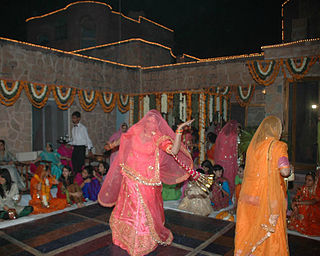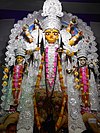Related Research Articles

A folk dance is a dance that reflects the life of the people of a certain country or region. Not all ethnic dances are folk dances. For example, ritual dances or dances of ritual origin are not considered to be folk dances. Ritual dances are usually called "religious dances" because of their purpose.

Owing to India's vastness and diversity, Indian music encompasses numerous genres in multiple varieties and forms which include classical music, folk, rock, and pop. It has a history spanning several millennia and developed over several geo-locations spanning the sub-continent. Music in India began as an integral part of socio-religious life.

Dance in India comprises numerous styles of dances, generally classified as classical or folk. As with other aspects of Indian culture, different forms of dances originated in different parts of India, developed according to the local traditions and also imbibed elements from other parts of the country.

Indian folk music is diverse because of India's enormous cultural diversity. It is sung in various languages and dialects throughout the length and breadth of this vast nation and exported to different parts of the world owing to migration.

The culture of Kerala has developed over the past millennia, influences from other parts of India and abroad. It is defined by its antiquity and the organic continuity sustained by the Malayali people. Modern Kerala society took shape owing to migrations from different parts of India and abroad throughout Classical Antiquity.

Ghoomar or ghumar is a traditional folk dance of Rajasthan. It was the Bhil tribe who performed it to worship Goddess Saraswati which was later embraced by other Rajasthani communities. The dance is chiefly performed by veiled women who wear flowing dresses called ghaghara. The dance typically involves performers pirouetting while moving in and out of a wide circle. The word ghoomna describes the twirling movement of the dancers and is the basis of the word ghoomar.
There are many different dances of the Tripuri people, the largest ethnic group in the state of Tripura.
Punjabi dances are an array of folk and religious dances of the Punjabi people indigenous to the Punjab region, straddling the border of India and Pakistan. The style of Punjabi dances ranges from very high energy to slow and reserved, and there are specific styles for men and women.

The Kalbelia are a snake charming tribe from the Thar Desert in Rajasthan, India. The dance is an integral part of their culture and performed by men and women.

Puli kali is a recreational folk art from the state of Kerala, India. It is performed by trained artists to entertain people on the occasion of Onam, an annual harvest festival, celebrated mainly in the Indian state of Kerala. On the fourth day of Onam celebrations, performers painted like tigers and leopards in bright yellow, red, and black shake their bellies and dance to the beats of instruments like Udukku and Thakil. Literal meaning of Pulikkali is 'The tiger dance' hence the performance revolve around the theme of tiger hunting. Folk art is mainly practiced in Thrissur district of Kerala. The best place to watch the show is at Thrissur on the fourth day of Onam, where Pulikkali troupes from all over the district assemble to display their skills. The festival attracts thousands of people to the Thrissur city. Pulikkali is also performed during various other festive seasons.
Kummi is a folk dance, popular in Tamil Nadu and Kerala in India, danced mostly by South Indian women in circle. Dancing may be different. In some places, it is very simple, with rhythmic clapping or beating of the drums. In other places dancers imitate various harvesting activities. Kummi often accompany by songs, called "Kummi songs". It is often danced during festivals. It is also danced by Tamils of Sri Lanka. Kummi songs became a popular addition to kuthiyottam festivities in modern times.
Tamil Nadu has a rich history of art and entertainment. The three modes of entertainment classified as Iyel (Literature), Isai (Music) and Nadagam (Drama) had their roots in the rural folk theatre like Theru Koothu. Many forms of group and individual dances with the classical forms for popularity and sheer entertainment value. Some of the dance forms are performed by Tribal people. The majority of these dances are still thriving in Tamil Nadu today.

Sunil Kothari was a noted Indian dance historian, scholar and critic. He was also former Uday Shankar Professor at Ravindra Bharti University, Kolkata.
Several folk dance forms evolved in different regions of Odisha, Odissi and Chhau being some popular forms. Sambalpuri dance is most popular dance of western Odisha and is enjoyed by many.

Bhangra is a type of traditional folk dance of Punjab, originating in the Sialkot area of Punjab, Pakistan. It is done in the season of harvesting. According to Manuel (2001), bhangra is especially associated with the vernal Vaisakhi festival.
Yamunabai Waikar, née Yamunabai Vikram Jawle was an Indian folk artist, known for her expertise in the Marathi folk traditions of Lavani and Tamasha, folk art forms involving music and dance and reported to be one of the leading exponents of the art genres. A recipient of the Sangeet Natak Akademi Award, she was honored by the Government of India, in 2012, with the fourth highest Indian civilian award of Padma Shri.
Sonam Tshering Lepcha was an Indian folk musician, composer and lyricist. He was the first among Lepcha people to air his voice on All India Radio and was credited with the revival of Lepcha culture, one of the indigenous cultures of the Indian state of Sikkim. He was reported to be credited with over 400 folk songs, 102 folk dances and 10 dance dramas. He died on 30 July, 2020 due to cardiac arrest.

Manjamma Jogathi, is an Indian theatre actress, singer and dancer of Jogathi Nritya, a folk dance form of North Karnataka. In 2019, she became the first transgender woman to be the president of Karnataka Janapada Academy, state's top institution for folk arts. In January 2021, Government of India announced Padma Shri award for her contribution to the field of folk arts.
Ram Sahay Panday is a Rai dancer from Sagar in the Indian State of Madhya Pradesh. The Rai dance was traditionally associated with the Bedia community which itself was associated with flesh trade. In spite of the fact that he was not a member of the community, he devoted his whole life to the practice and performance of the Rai dance and to secure acceptance and respectability to the dance form. His untiring efforts helped obtain national and international recognition to this dance form.
References
- ↑ "music and Dance - Egiye Bangla". wb.gov.in. Retrieved 2020-10-25.
- ↑ "Folk Dances of East India". www.culturalindia.net. Retrieved 2020-10-25.
